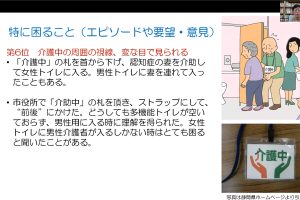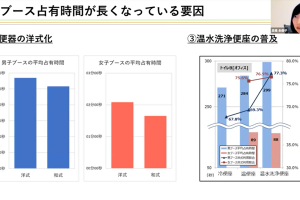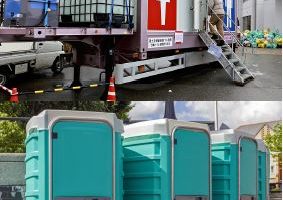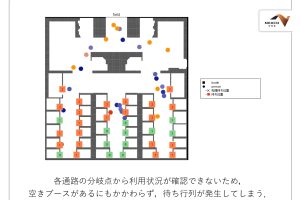Title: The 6th seminar “Accessible Toilet for everyone including gender and sexual diversity”
Date: 30 September 2021 (Thu) 18:00-20:00 JST
Presenters: Akiko Hino, LIXIL Corporation,
Mikiko Takahashi, Ph.D., Company Incorporation
【Part1:Basics of gender and sexual diversity:Akiko Hino, LIXIL Corporation】
“Gender and sexuality” are diverse and different by each person. In addition to the two gender groups of men and women, there is the third category group in the passport of some countries such as Australia and Canada. In recent years, it is a global trend to recognize the human sexuality with dividing into four basic factors and composing by combination with them.
1. Sex characteristics, 2. Gender identity, 3. Sexual orientation, 4. Gender expression.
This issue is not simply and clearly divided into “men” or “women” but it can be said “gradation.” The most important thing is that the combination of these four factors is the person’s sexuality and must be a part of the individual personality. It is a human right not to be forced or robbed by anybody.
SOGI means Sexual Orientation and Gender Identity. Lesbian, Gay, Bisexual and Transgender (LGBT) is one of the generic names for gender and sexual minorities. In terms of sexuality, everyone is the same situation and the only difference is whether they belong a minority or a majority. LGBT people are not anything special compared to others.
The sexually oriented minority is called heterosexual. The majority of gender identity is called cisgender. In recent years, it is sometimes called as “LGBTQ” by adding “Q” from “questioning” or “queer”, and furthermore including people of various sexualities as “LGBTQ +.”
The definition of “transgender” is a person whose gender at the birth and the gender identity are different according to WHO and plural number of academic society reports.
On the contrary, the definition of “cisgender” is a person whose gender and the identity is the same. Transgender includes not only the cross identification of genders, but also woman like or man like, non-binary (neither man nor woman; genderqueer, neutrois, agender, and X-gender (original category in Japan)). Transgender varies depending on the combination of gender at the birth and gender identity and can be generally divided into four genders.
A female person assigned gender at the birth but X gender identity is called FTX. A female at the birth and the gender identity is male is called FTM or trans-man. A male person at the birth but the gender identity is female is also called MTF or trans-woman. A male person at the birth but X-gender gender identity is called MTX.
Actually the degree of gender discomfort is varies from person to person.
Gender identity disorder disability is a medical diagnosis for a person who suffers from an intensive gender identity disorder among transgender people. However, it is up to each person to determine how much they can manage even if they receive a diagnosis. WHO decided to abolish the expression “gender identity disorder” and changed “gender incongruence.”
(Background of Research Group on Office Restrooms for All-Gender Use)
LIXIL Corporation and NPO Nijiro Diversity Group surveyed in 2015 and found that many transgender people could not access to the public and office toilets even they want to use.
The tendency was stronger in offices and schools than in public toilets. Then we particularly focus on the serious issues of office toilets. Kanazawa University, COMANY inc., and LIXIL Corporation launched “Research Group on Office Restrooms for All-Gender Use” in August 2017.
Based on the idea that the toilet is one of the fundamental human rights as well as human dignity. The research purpose is to survey an office toilet environment where anyone can use it comfortably with peaceful mind regardless of gender identity.
Conclusion
It is necessary to understand each other in order to realize a symbiotic society with the diversity. People will imagine and consider by means of understanding. Even those who do not know transgender well because never met them can gain the knowledge from the survey. At this time, we would like you to know about the issues of using toilet by the transgender people.
——————————————————————————–
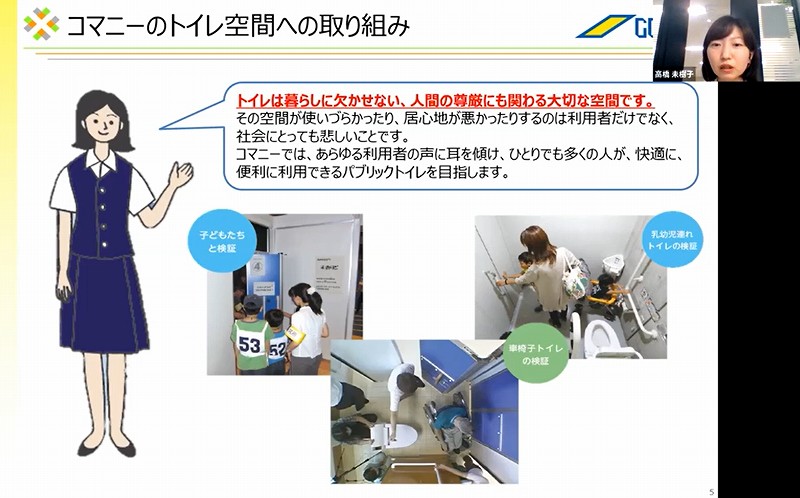
【Part 2: What is the future of toilets? From a survey on transgender toilet use:Mikiko Takahashi, Ph.D., COMANY inc.】
COMANY inc. considers the toilet to be an important space under human dignity and wishes to create an environment where everyone can use comfortably whenever they want to use it.
Kanazawa University, LIXIL Corporation. and COMANY inc. launched “Study Group on All-Gender Use of Office Toilet” in 2017 and conducted a survey. 30,000 monitors aged from 18 to 59 who work in the office participated by means of internet survey in November 2017. Furthermore we asked selected monitors about their employment status and gender issues in detail of the actual toilet use condition.
In addition to 824 cisgender (412 men and women each) and transgender of the survey company registration monitor, we asked SNS and LGBT-related organizations to increase the number of respondents by 299 people.
Then, in order to investigate in detail, we conducted a group hearing survey by those selected from the respondents of the internet survey.
In the survey of 30,000 people working in the office, 600 people (2%) were transgender. However the degree of gender identity varied among these 600 people including such as X-gender from person to person. Surveys by the transgender were conducted both in Japan and abroad although their proportion varies.
At the survey, there are two choices of male or female at the birth, however we asked in detail regarding gender identity, not only male/female, but rather male, rather female, X-gender/neutral/asexual, unrecognized. After that, people with different gender identity from the registration at the birth were judged to be “transgender.” Following to WHO, we included X-gender in transgender at the survey.
We asked about the overall satisfaction of the daily use office toilets with a scale of 100%. The average cisgender score was 70.4% without the difference between men and women. On the other hand, transgender was 61.2%, which was nearly 10% lower than cisgender, and X-gender was the lowest of 60%. It assumed the reason transgender complains is that they are not able to use the toilet they want to.
About 40% of transgender people unsatisfied with the actual situation of the office toilets. The remaining 60% of the respondents satisfied but only 16% were able to use the gender toilet as they wished. More than 30% of them used the toilet of the register gender at the birth, but this seems that someone gave up or used it because it was difficult to be coming out at the office.
We also asked about their satisfactions of several terms of the toilet, both cisgender and transgender unsatisfied for limited choices of toilet.
There are various requests that transgender wants to use the toilet, such as those who want to use toilets regardless of the gender, whereas those who want to use gender-separated toilets or multi-functional toilets. Some of them request a unisex toilet that is different from the multi-functional toilet. Because there are less number of the multi-functional toilets in the office because offices are not obliged it under the Barrier Free Law. And more transgender than cisgender said that even if there is a multi-functional toilet, they feel sorry to use it because it is regarded to be prepared for people with disabilities.
Considering this, it may be necessary to have something like a unisex toilet that is different from multi-functional toilet in the future. However, if this unisex toilet becomes to focus to be used by transgender, there will be an issue that this toilet may lead to involuntary coming out.
We asked both cisgender and transgender that “Would you like to use, if there is toilet facility with men’s and women’s toilet, a multi-functional toilet, and a unisex toilet with a hand-washing device like in a convenience store?” 57.3% of cisgender and 77.9% of transgender answered “I will use it every day” or “I will use it depending on the conditions and circumstances.” The result by cisgender there are big difference between men and women that 43.7% of women answered that they would not use it.
Considering the reason why women don’t want to use it, the most common cisgender is resistance in using the same toilet with the opposite sex. What we heard from a transgender is that using a unisex toilet will be regarded as a sexual minority, and they concern that it will be seen by other people curiously.
When we asked about the conditions for use, 34.2% of cisgenders requested a larger room space of the cubicle. This is the same request by transgender. The other items were such as ensured privacy, substantial auxiliary equipment and ensured security. There were unique request by transgender that are concerned about the public eyes around them, such as to make the entrance and exit of the unisex toilet invisible by others or declaring that everyone can use it to cover up the propensity. Perhaps they worry that unisex toilets may be regarded as a special toilet for transgender.
In order to make a unisex toilet easy to use by many people, it is quite important that the basic elements of a toilet must be clean, without waiting, and without bad smell. Additionally it is important that the space of cubicle is large enough and the facilities attached are substantial.
(Arrangement of easy-to-use unisex toilets)
We made five examples of unisex toilet and surveyed the layout of easy-to-use toilets. We asked cisgender and transgender through the internet and hearing surveys. One example that faces the aisle and meets people who use the gender-separated toilets at the entrance or exit of the unisex toilet was poorly evaluated. Transgender evaluated a good one which was difficult to be recognized at the entrance or exit. Even if it was seen at exiting, it was possible to excuse for using the unisex toilet because the other toilets were fully occupied. There found three keywords for evaluation: entering or exiting situations and easy to excuses.
(Pictogram of unisex toilet)
Many transgender people did not wish a special toilet sign. Many transgender people were uncomfortable with a sample pictogram with half men and women.
(Awareness and prejudice from cisgender to transgender)
About 40% of transgender people cannot access to the ideal toilets where they always want to use. The reasons for this are “I want to use a women’s toilet by a self-identified gender but some people dislike it (MTF)” and “the employing company orders me to use a women’s toilet based on my gender registration (FTM).” Many people say that they cannot use the toilet they want due to the other cisgender reaction.
Moreover we asked cisgender if they were reluctant to use a toilet if transgender use it under their self-identified. More than 60% of the respondents answered that they did not feel resistance. On the other hand, 30% of both men and women pointed they feel resistance. There are some reasons that they feel resistance because they do not understand the transgender well.
We asked them what they thought of using a toilet of a gender that transgender self-identified. “No resistance” was more than 10 percent higher for those who did training for gender and sexual minorities than for those who did not.
(Summary)
There are two points of the toilet that everyone can use easily.
(1) Choices: It is important to create the toilet variety selection and it must be easy to use.
(2) The prejudice elimination: It is not only the physical issue but also the issue to eliminate the prejudice from the ignorance. The lectures on the gender and sexual minorities are effective to let people know about diversity society.
——————————————————————————–
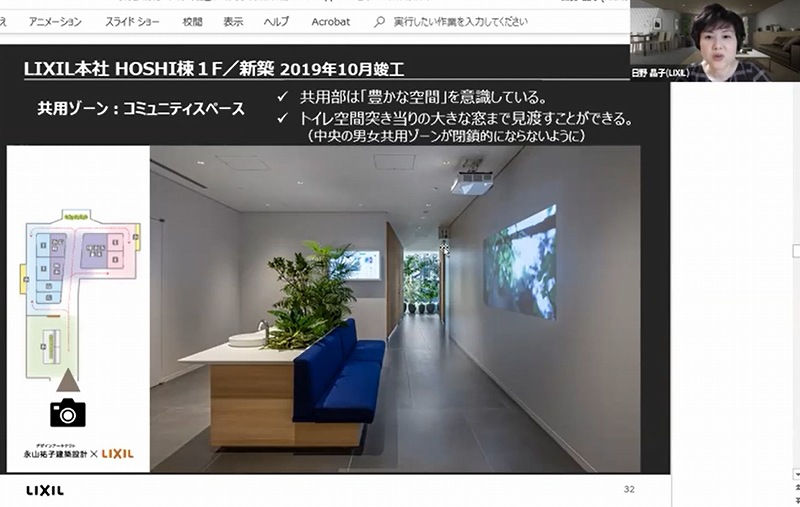
【Part 3: Introducing solutions of toilets for all-gender use: Akiko Hino, LIXIL Corporation】
There are four possible solutions for developing toilets to use regardless of the gender identity.
(1) Consider the facility specifications of separated men’s and women’s toilets.
(2) Define the multi-functional toilet as “All gender toilet.”
(3) Install a wide space unisex toilet.
(4) All toilets are of private cubicles depending on users selectable.
There is a possibility to combine of these solutions, however impossible to find the correct answer and then let us consider and discuss together.
(1) Consider the specifications of the men’s and women’s toilets.
Some transgender people want to use the gender-separated toilets and some have already used them. There are ways to use toilets for the transgender, one is according to the assigned gender at the birth and the other is the gender identity. The choice depends on each person’s situation which one to use. If transgender difficulties are resolved, cisgender will be able to use the toilet more comfortably with peace of mind.
On the other hand, some of them want to use the multi-functional toilet and already use it.
(2) Define the multi-functional toilet as an “All gender toilet.”
Most of the multi-functional toilets are unisex and then transgender can use them without worrying about gender issue. Since it is used by various people, it is inconspicuous and there is a sense of security. In fact, transgender people who have difficulty using both men’s and women’s toilets often want to use multi-functional toilets.
According to LIXIL Corporation survey, 58% of transgender said that using the multi-functional toilet was awkward. When using it, they feel guilty if someone with a disability came to use or they were warned by somebody. Some of them said it would be quite helpful if there is a unisex toilet which is different from a multi-functional toilet.
(3) Install a wide space unisex toilet
“A wide space toilet” is named by LIXIL Corporation as a unisex private cubicle toilet that can be completed from excretion to hand washing at one stop. This will be installed as an alternative to the multi-functional toilet. It can be used casually without worrying about gender and expected to eliminate the awkwardness when using a multi-functional toilet with relax atmosphere.
There are some cases where parents and children have different genders, or people with intellectual or developmental disabilities need to be guarded in the cubicle even if they are adults. There is also opposite gender care for people with dementia. There are a certain number of needs for unisex toilets that are different from multi-functional toilets from not only transgender but also cisgender.
(4) All toilets are of private cubicles depending on users selectable.
A private toilet is not a simple cubicle but an independent private cubicle separated by walls.
– Install toilets for wheelchair users, ostomates, and families with infants.
– This may include multi-functional toilet.
– Apart from above, a women’s toilet, a men’s toilet and a unisex toilet are to be installed.
– They are depending on users selectable.
There are toilets with solely unisex private cubicles in Sweden. LIXIL Corporation has created an “Alternative Toilet” at the head office under the concept of “Choose a private cubicle that suits you.”
There are still problems when all cubicles are private ones. When private cubicles are partitioned by walls, the doors are closed all the time. It is difficult to recognize its availability. It is also difficult to visually recognize where and what kind of toilet is facilitated. When a private cubicle is equipped with a hand-washing basin and a mirror inside, a problem must be occurred that the occupation time must be extended.
In fact there are many people reluctant to use the unisex toilet itself.
(Conclusion)
The access to the toilet is one of the basic human rights. In fact it is very important to shift the awareness of the toilet access, it must take many years to change. We believe it is necessary to consider improvement measures in both sides of physical environment and awareness.
——————————————————————————–
【Q&A】
[Q:S]: Is there any junior high school where a unisex toilet is installed?
[A:Hino]: There is an example of installing a private cubicle which is to be used not only a wheelchair child but also others. However, there are some pupils in the second or third grade of elementary school who does not like to use toilet where is different from the gender identity. We recognized this issue starts before junior high school on some students.
[A:Hino] There are few multi-functional toilets that anyone can use regardless of the gender. The people who have difficulty to use the gender-separated toilets can use multi-functional toilet. Because it is getting to be busy, some wheelchair users complain that they don’t look like people with disabilities.
[A: Takahashi] When the unisex toilet is only for transgender, it becomes a coming out toilet. I think it is favorable for more people to use it, but the cubicle numbers should be considered according to the actual usage and user profiles. [Q: O] If someone whose gender at the birth and the gender identity seems to be obviously different uses a toilet of its gender identity, then problem occurs. How about an idea of separating the entrance and exit in the toilet?
[A: Hino] Especially when unisex toilet design, we try not to make dead ends. I think there are few successful cases in architecture except at stadiums. Additionally they feel relieved with a wide aisle and a bit larger space. Transgender cares mostly about getting involved trouble. It is unlikely that women’s toilets will be used by a person appearing like men. Whereas it is a crime if a cisgender man comes in women’s toilet pretending transgender. [Q:H] Isn’t it more realistic to create more multi-functional toilets instead of unisex toilet?
[A: Takahashi] It is still early to make everything multi-functional toilets or unisex ones since not all people like to use them.
[A: Hino] When we surveyed by asking if all of them are unisex toilets, about 80% of women in commercial facilities and nearly 90% of women in offices do not want to use them. On the contrary, the percentage of men is 30% and 45% respectively. There is a big difference between men and women preferences.
[A:O] I think the difference comes from whether the toilet is a place to excrete or a place to fell relax.



